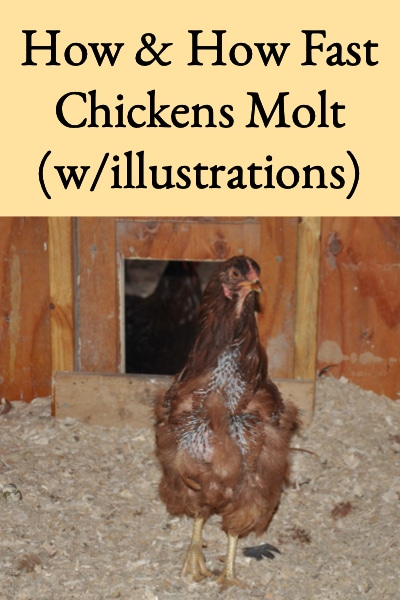
How Chickens Molt
Molting is a natural occurrence for chickens triggered by shortening day length in the fall. It can take from 2 to 6 months for a chicken to complete molting.
Egg production generally stops during molting for pure breed birds or significantly slows down for egg-laying breeds. This egg production slowdown occurs because it takes the same nutrients to grow feathers that it does to make eggs.
Chickens that start molting late in the fall usually complete molting quickly (in 2 -3 months) whereas chickens that start in early fall generally take much longer to complete molting (4 – 6 months).
Obviously, since they’re producing fewer (or zero) eggs during molting, the better producers are those hens that start molting late and finish quickly. A chicken that molts for six months is much less productive than a chicken that molts in two months. The hens to consider culling are those that start molting early and take a long time to complete.
Chickens molt their feathers in sequence; starting at the head, neck, back, breast, stern, thighs, wings, and finally the tail.
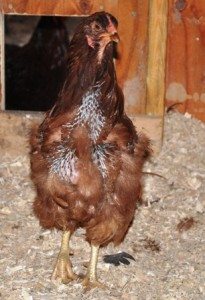
Molting Chicken
How Fast Chickens Molt
You can tell how long a hen has been molting, and how much longer she’ll continue to molt, by looking at her primary feathers. Chickens have ten primary feathers on each wing – the orange-colored feathers shown in the illustration below.
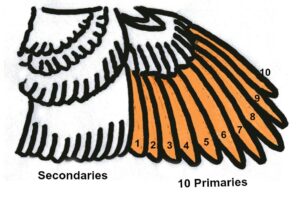
Feathered Chicken Wing Prior To Molting
When molting, a bird drops primaries approximately every two weeks, and each one takes about six weeks to regrow. A slow-molter will drop primaries one at a time and will take up to 24 weeks to re-feather. Fast-molters drop their primaries in groups instead of one by one and therefore return to production much faster.
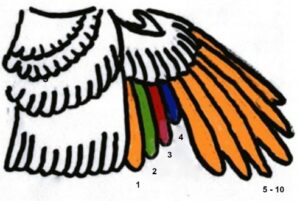
Slow Molting Chicken Primaries
The illustration above shows how a slow-molting chicken loses and regrows her feathers. In this illustration, primary #1 (in orange) was dropped and has fully regrown (so it’s six weeks old); primary #2 (in green) was dropped and is four weeks old; primary #3 (in red) was dropped and is two weeks old, and primary #4 (in blue) was dropped and just started regrowing.
This chicken is losing primaries one at a time, has been molting for six weeks and will continue for eighteen weeks more. It will take six more weeks for primary #4 to mature, eight more weeks for primary #5 to drop and mature, ten more weeks for #6 to drop and mature, and so on. That means it takes 24 weeks or about six months for a bird that molts this way to return to production.
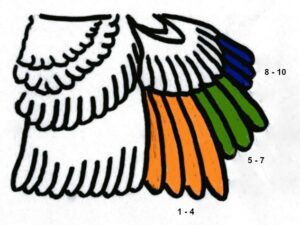
Fast Molting Chicken Primaries
The final illustration above shows what happens with a faster molting bird. In this figure, primaries #1 – #4 (in orange) were dropped together and have fully regrown in six weeks. Primaries #5 – #7 (in green) were dropped, are regrowing, and are four weeks old. Primaries #8 – #10 (in blue) were dropped, are regrowing, and are two weeks old. This chicken is dropping primaries in groups, has been molting for six weeks, and will continue to molt for four more or a total of ten weeks.
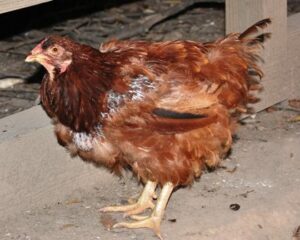
Molting Chicken With Most Primaries Gone
Most chickens will complete molting somewhere between the above two examples. However, when you see a hen that’s dropped many primary feathers, you should keep her. She’s a better-producing chicken, while those that drop feathers slowly are candidates for culling (for more on culling, see Fall Chicken Culling – Which Birds To Cull & How To Use Them). Chickens eliminated because of slow molting are best used as stewing chickens since they’re over a year old.
Tessa says
Whaaaaa?! That is an awesome thing to know!
Dawn says
So when they molt at this time of year,(it is really cold here in MN now).. I am guessing to have a heat light going but could I loose the chicken to the cold easier with that much less feathers?
Lesa says
Hi Dawn, the feathers are what keep the chickens warm, so if you’ve got some with few feathers then you could potentially lose a chicken to cold weather. You’ll have to judge whether you need to set up a heat lamp based on the temperatures and how many feathers they have.
michelle says
Okay so I should check the primary feathers. How do I know what is good. So If all the primaries are missing is that a good thing and if only one or two is missing that is a bad thing? Am I right?
Lesa says
Michelle, that’s a really good question, and in general you’re right. But, I’ll put together a better explanation and some illustrations/pictures showing how the primaries are molted for both a fast and slow molter, and a better explanation of how you can tell how long they’ve been molting, and how long they’ll continue to molt for the next blog post this Sunday.
Doris says
Molting Chickens….Lesa, I learn something new every time I read your blog. Who knew? Not this city girl. Interesting blog.